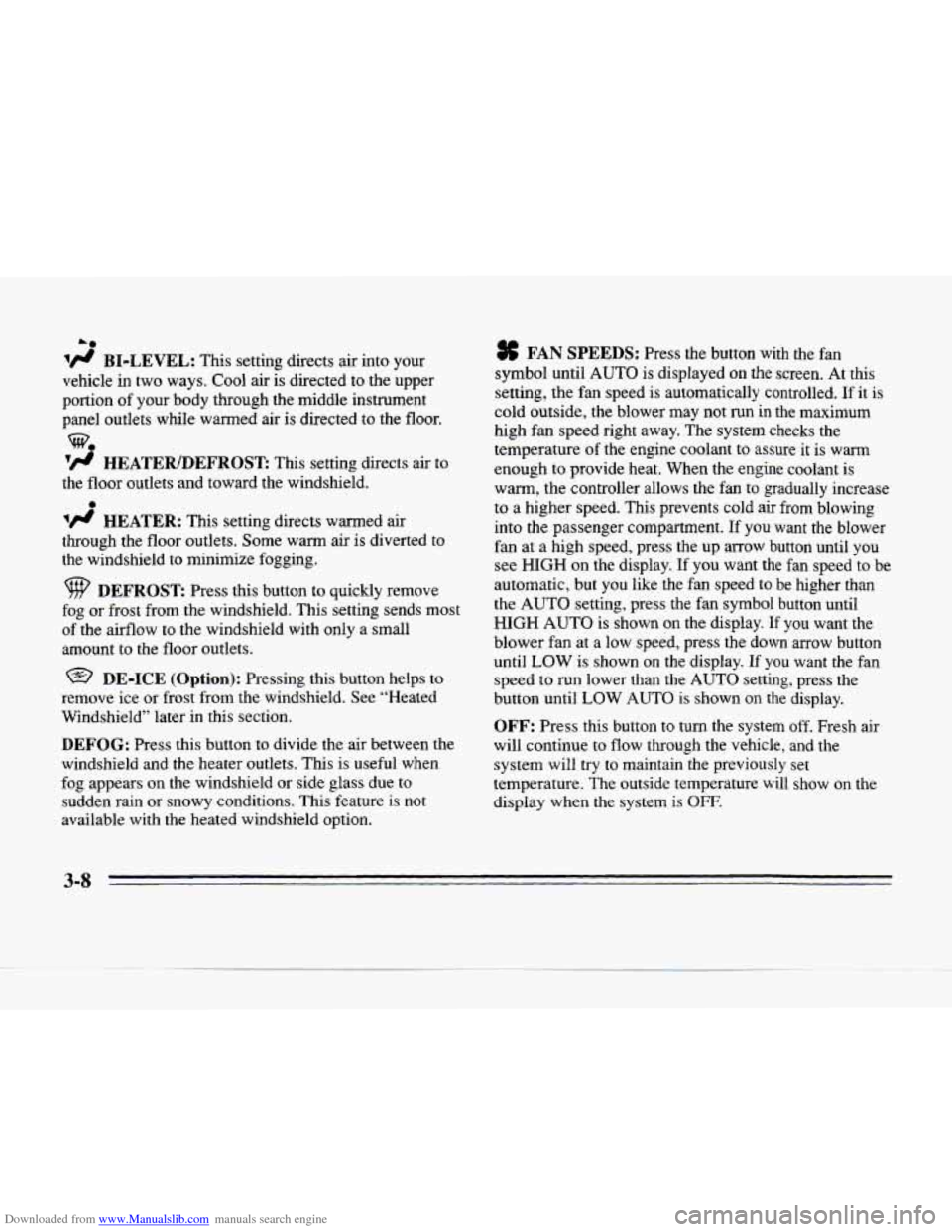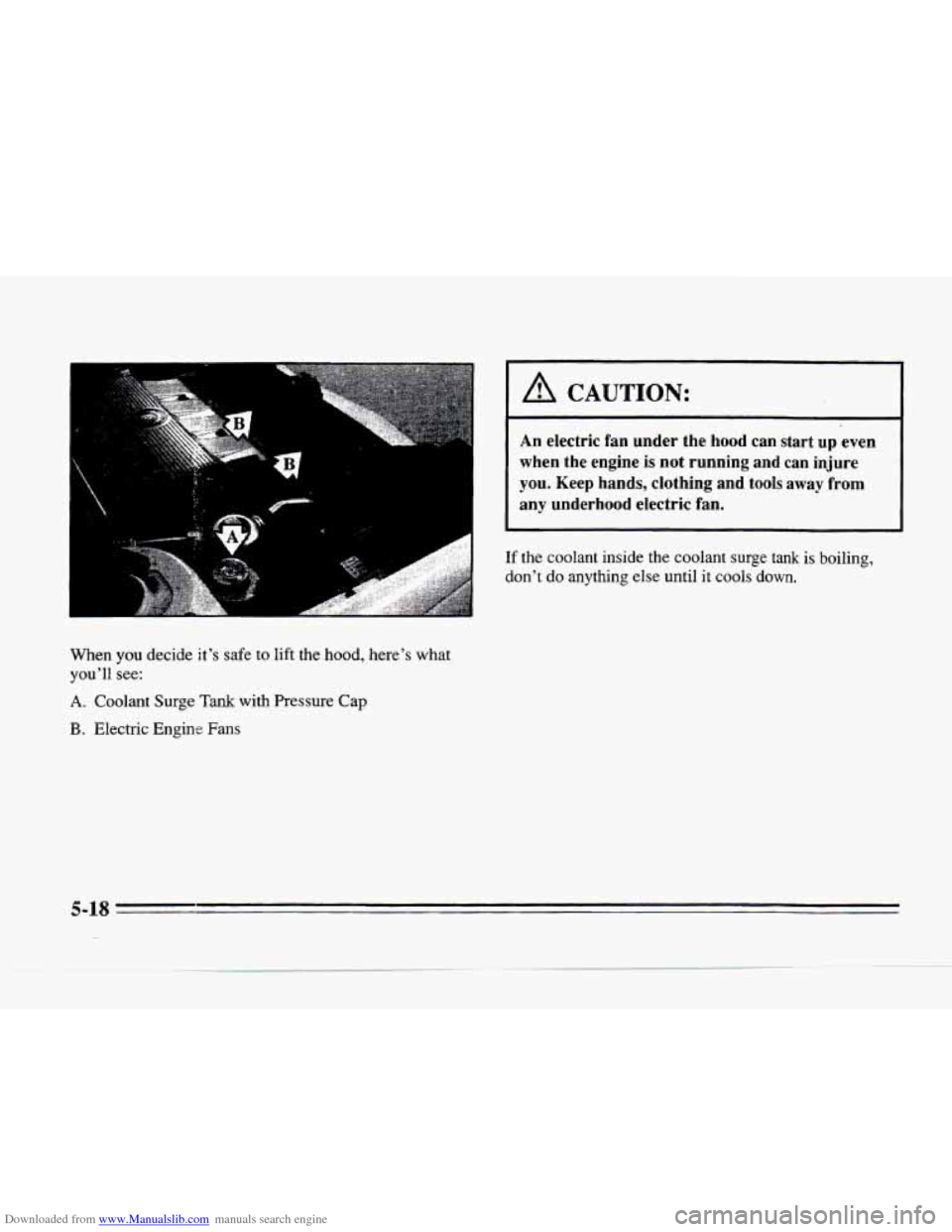1996 CADILLAC SEVILLE engine coolant
[x] Cancel search: engine coolantPage 151 of 354

Downloaded from www.Manualslib.com manuals search engine DEFOG: Press this button to divide the air between the
windshield and the heater outlets. This
is useful when
fog appears on the windshield or side glass due to
sudden rain
ox snowy conditions. This feature is not
available with the heated windshield option.
AUTO/ECON: Press this button to switch between
AUTO and ECON. The ECON setting attempts to keep
air at
a selected temperature, however, it does not
remove humidity from the air. Use this setting in cold or
cool weather to save fuel. The
AUTO setting is used
when it’s warm outside and you need
to cool the air in
order to maintain a selected temperature and blower
speed.
* FAN SPEEDS: Press the button with the fan
symbol until
AUTO is displayed on the screen. At this
setting, the fan speed is automatically controlled. If it
is
cold outside, the blower may not run in the maximum
high fan speed right away. The system checks the temperature
of the engine
coolant to assure it is warm
enough to provide heat. When the engine coolant is
warm, the controller allows the fan to gradually increase
to a higher speed. This prevents cold air from blowing
into the passenger compartment.
If you want the blower
fan at
a high speed, press the up arrow button until you
see
HI on the display. If you want the fan speed to be
automatic, but you like the fan speed to
be higher than
the
AUTO setting, press the fan symbol button until .HI
AUTO is shown on the display. If you want the blower
fan at
a low speed, press the down arrow button until
LO is shown on the display. If you want the fan speed to
run lower than the
AUTO setting, press the button until
AUTO LO is shown on the display.
DEFROST Press this button to quickly remove
fog or frost from
the windshield. This setting sends most
of the airflow to the windshield with only a small
amount to
the floor outlets.
3-4
Page 154 of 354

Downloaded from www.Manualslib.com manuals search engine c
c
With this setting, the air conditioning compressor
automatically cycles when needed to cool the air.
In cold
weather, when the system senses the need for heat, the
airflow will be directed out
the floor outlets. As the
interior temperature approaches a desired setting, the
blower speed
will decrease. To maintain interior
comfort, the airflow may move
to the instrument panel
air outlets and floor outlets
(BI-LEVEL mode). On
bright sunny days in cold weather, the airflow may come
out
of the A/C outlets (AC mode) to maintain comfort
and prevent stuffiness.
If your vehicle is sitting
out on a hot day and you have it
set on AUTO, the air will first flow out the floor air
outlets for a few seconds. That is normal. This
is to
expel hot air in the air outlets. As the air is cooled, the
airflow will move through the A/C outlets. If you start
your vehicle
with the fan setting on HI it will skip the
A/C Purge.
To avoid blowing cold air in cold weather, the system will
delay turning on the fan until warm
air is available. The
length of delay depends on the outside
air temperature,
engine coolant temperature or the time since the'engine
was last started.
As the coolant warms up, the blower fan
speed will gradually increase and
air will flow from the
heater outlets, with some airflow to the windshield to
prevent fogging under most normal conditions.
If you leave your vehicle, the system will remember the
control setting the next time you start your engine,
except for recirculation and defrost. Each ignition cycle
cancels recirculation, whereas,
DEFROST will change
to AUTO when the ignition is shut off and then turned
back
on.
Manual Operation
You may manually adjust the air delivery mode or fan
speed.
be
/I AC: This setting directs airflow through the
middle instrument panel outlets.
3-7
Page 155 of 354

Downloaded from www.Manualslib.com manuals search engine A*
BI-LEVEL: This setting directs air into your
vehicle
in two ways. Cool air is directed to the upper
portion
of your body through the middle instrument
panel outlets while warmed air
is directed to the floor,
’’ HEATER/DEFROS’E This setting directs air to
the floor outlets and toward the windshield.
’/J HEATER: This setting directs warmed air
through the
floor outlets. Some warm air is diverted to
the windshield to minimize fogging.
w.
0
DEFROST Press this button to quickly remove
fog
or frost from the windshield. This setting sends most
of the airflow to the windshield with only a small
amount to the
floor outlets.
@? DE-ICE (Option): Pressing this button helps to
remove ice or frost from the windshield. See “Heated
Windshield’’ later in this section.
DEFOG: Press this, button to divide the air between the
windshield and the heater outlets. This is useful when
fog appears on the windshield or side glass due
to
sudden rain or snowy conditions. This feature is not
available with the heated windshield option.
% FAN SPEEDS: Press the button with the fan
symbol until
AUTO is displayed on the screen. At this
setting, the
fan speed is automatically controlled. If it is
cold outside, the blower may not run
in the maximum
high fan speed right away. The system checks the
temperature of the engine coolant
to assure it is warm
enough
to provide heat. When the engine coolant is
warm, the controller allows the fan to gradually increase
to a higher speed. This prevents cold air from blowing
into the passenger compartment.
If you want the blower
fan at
a high speed, press the up arrow button until you
see HIGH on the display. If you want the fan speed to be
automatic, but you like the fan speed
to be higher than
the
AUTO setting, press the fan symbol button until
HIGH AUTO is shown on the display. If you want the
blower fan at a low speed, press the down arrow button
until
LOW is shown on the display. If you want the fan
speed
to run lower than the AUTO setting, press the
button until LOW AUTO is shown
on the display.
OFF: Press this button to turn the system off. Fresh air
will continue to flow through the vehicle, and the
system will try to maintain the previously
set
temperature. The outside temperature will show on the
display when the system is OW.
3-8
*
Page 236 of 354

Downloaded from www.Manualslib.com manuals search engine L
rc
Engine Overheating
You will find an ENGINE COOLANT HOT-IDLE
ENGINE message
or a STOP ENGINE ENGINE
OVERHEATED message on the Driver Information
Center. There is also an engine temperature warning
light on the instrument panel. See “Engine Temperature
Warning Light”
in the Index.
Overheated Engine Protecaon Operating
Mode
Should a low coolant condition exist and the message
STOP ENGINE ENGINE OVERHEATED is displayed,
an overheat protection mode which alternates firing
groups
of four cylinders helps prevent engine damage.
This operating mode allows your vehicle
to be driven
to
a safe place in an emergency; you may drive up to
50 miles (80 km). Towing a trailer in the overheat
protection mode should be avoided.
NOTICE:
After driving in the Overheated Engine
Protection Operating Mode, to avoid engine
damage, allow the engine to cool before
attempting any repair. The engine oil may be
severely degraded. Change the
oil and reset the
oil life indicator. See “Engine Oil, When to
Change” in the Index.
5-15
Page 237 of 354

Downloaded from www.Manualslib.com manuals search engine If Steam Is Coming From Your Engine
A CAUTION:
Stcam from an overheated engine can burn you
badly, even if you just open the hood. Stay away
from the engine if you see
or hear steam coming
from it. Just turn it
off and get everyone away
from the vehicle until it cools down. Wait until
there
is no sign of steam or coolant before
opening the hood.
If you keep driving when your engine is
overheated, the liquids in it can catch fire.
You
or others could be badly burned. Stop your
engine if it overheats, and get out of the vehicle
until the engine is cool.
NOTICE:
If your engine catches fire because you keep
driving with no coolant, your vehicle can
be
badly damaged. The costly repairs would not be
covered by your warranty. See “Overheated
Engine Protection Operating Mode” in the Index.
c
5-16
Page 239 of 354

Downloaded from www.Manualslib.com manuals search engine When you decide it's safe to lift the hood, here's what
you'll see:
A. Coolant Surge Tank with Pressure Cap
B. Electric Engine Fans
I A CAUTION:
An electric fan under the hood can start PIP even
when the engine is
not running and can injure
you. Keep hands, clothing and tools away from
any underhood electric fan.
If the coolant inside the coolant surge tank is boiling,
don't do anything else until
it cools down.
5-18
h
Page 240 of 354

Downloaded from www.Manualslib.com manuals search engine L
L
4
-,. .
The coolant level should be indicated by a CHECK
COOLANT LEVEL message on the Driver Information
Center.
If it isn't, you may have a leak in the radiator
hoses, heater hoses, radiator, water
pump or somewhere
else in the cooling
system.
A CAUTION:
Heater and radiator hoses, and other engine
parts, can be very hot. Don't
touch them. If you
do, you can be burned.
Don't run the engine if there
is a leak. If you run
the engine, it could lose all coolant. That could
cause
an engine fire, and you could be burned.
Get any leak fixed before you drive the vehicle.
5-19
Page 241 of 354

Downloaded from www.Manualslib.com manuals search engine I NOTICE:
Engine damage if you keep running your engine
without coolant isn’t covered
by your warranty.
See “Overheated Engine Protection Operating
Mode’? in the Index.
If there seems to be no leak, with the engine
on, check to
see if
the electric engine fans are running. If the engine
is overheating, both
fans should be running. If they
aren’t, your vehicle needs service.
How to Add Coolant to the Coolant Surge
Tank
If you haven’t found a problem yet, but the coolant level
isn’t at the proper level (2.5 inches (60 mm) below the
base of the fill neck), add
a 50/50 mixture of clean
water (preferably distilled) and DEX-COOL TM
antifreeze at the coolant surge tank, but be sure the
cooling system, including the coolant surge tank
pressure cap, is cool before
you do it. (See “Engine
Coolant” in the Index
for more information.)
A CAUTION:
Steam and scalding liquids from a hot cooling
system can blow out and
burn you badly. They are
under pressure, and if you turn the coolant surge
tank pressure
cap -- even a little -- they can come
out at high speed. Never turn the
cap when the
cooling system, including the coolant surge tank
pressure cap, is hot. Wait
for the cooling system
and coolant surge tank pressure
cap to cool if you
ever have to turn the pressure cap.
5-20